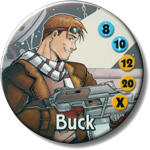[the start of a post from 2017 that I never got around to finishing] I think the theory of setting swing dice after a loss -- or in any situation when the other person's dice are all known in advance -- is pretty well established, though there can be many subtleties in unusual situations.
But it's still always hard to know at the very start of a match -- if BOTH players have skill or option dice (let alone "select dice" or "plasma dice", etc) -- what value to set for your swing die. Even the very simplest case --
Bunnies vs. Bunnies (or maybe even better:
Rikachu vs. Rikachu) -- requires some thought -- and maybe some game theory!
Rikachu's recipe is 1,1,1,1,Y [Y swing can be set to any size from 1 to 20].
This case is particularly simple -- and maybe even resolvable by hand, since, in a LARGE number of cases, the game is decided on the first roll. If I set my Y to be of size 1, and you set yours to any size greater than 1, then I win outright outright if you roll 2-5 on that die on the first turn (probability 4/Y); if you roll a number greater than 5 (probability (Y-5)/Y), we'll trade off 1-sided dice until the last turn, when you'll win unless you roll a 1 on your Y-swing (probability (Y-1)/Y)
[though what happens if you roll a 1 on the Y on the first turn and our dice are identical? there are some differences between official rules and the old buttonmen web site -- and I don't know what the buttonweavers web site does -- but, in essence, it's either a tie round and we reroll; or it's simply rerolled without being recorded as a tie. (
this is a dead link to a discussion of this point on the old buttonmen web site)
(The only nasty case is when BOTH Y dice are of size 1 and a tie on the coming-out roll is inevitable)
Anyway, leaving the tie aside:if your dice is of size 2-5, I'll win for sure! if your die is of size > 5, and ignoring the case where it rolls a 1,
you have (Y-5)/(Y-1) chance of surviving on the first turn, and then a (Y-1)/Y chance of rolling high enough to nab the win on the last turn... overall, this gives you a (Y-5)/Y chance of winning, so if Y>10, you're in good shape!
Of course, knowing that, maybe I shouldn't set my swing die to Y=1 in the first place! But it wouldn't be THAT hard -- though it's a little more complicated as there are many more possible opening rolls -- to do the same computation for any pair (Y
1,Y
2) of swing dice, and then figure out the
nash equilibrium


